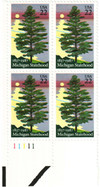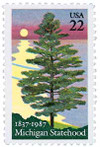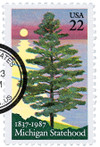
# 2246 - 1987 22c Michigan Statehood
U.S. #2246
1987 22¢ Michigan Statehood
- Issued for Michigan’s 150th statehood anniversary
- Pictures the state tree (white pine) and Lake Huron
Stamp Category: Commemorative
Value: 22¢, first-class rate
First Day of Issue: January 26, 1987
First Day City: Lansing, Michigan
Quantity Issued: 167,430,000
Printed by: Bureau of Engraving and Printing
Printing Method: Photogravure
Format: Panes of 50 in sheets of 200
Perforations: 11
Why the stamp was issued: To commemorate the 150th anniversary of Michigan statehood.
About the stamp design: Michigan native and professor at Detroit’s Wayne State University Robert Wilbert created his first-ever stamp design for this issue. The stamp pictures a Michigan white pine tree in front of a sunrise over Lake Huron, emphasizing the importance of the lumber industry and water transportation in the state’s early development.
First Day City: The First Day ceremony for this stamp was held at the Lansing Radisson Hotel, in Lansing, Michigan’s state capital.
History the stamp represents: On January 26, 1837, President Andrew Jackson approved Michigan’s bid for statehood.
French explorer Étienne Brûlé was likely the first European to visit Michigan when he explored the area around 1620. In 1634, Quebec Governor Samuel de Champlain sent Jean Nicolet to search for a route to the Pacific Ocean. Nicolet sailed through the Straits of Mackinac and explored the Upper Peninsula. In 1660, Father René Ménard established a Jesuit mission at Keweenaw Bay. The first permanent settlement was created by Father Jacques Marquette at Sault Ste. Marie in 1668.
France and Great Britain struggled for control of North America during the late 1600s and 1700s. By 1763, France was defeated and forced to relinquish control of most of its North American colonies. That same year, the Ottawa Indian Chief Pontiac led an uprising and massacred the British at Fort Michilimackinac and attacked several other forts. Pontiac’s forces laid siege to Detroit for five months, but were eventually turned away. In 1774, the British made Michigan a part of the province of Quebec.
After the Revolutionary War ended in 1783, America gained the Michigan area. However, the British kept control of Detroit and Fort Mackinac until 1796, to control the valuable fur trade. In 1787, Michigan became part of the first territory organized by the U.S. government, the Northwest Territory. A section of Michigan was organized as part of the Indiana Territory in 1800, and by 1803, all of Michigan was in the Indiana Territory. In 1805, Congress created the Territory of Michigan, which included the Lower Peninsula and the eastern portion of the Upper Peninsula. The British reclaimed Detroit and Fort Mackinac during the War of 1812. American forces took Detroit in 1813, but Fort Mackinac remained in British hands until 1814, after the war had ended. Many new settlers from the East came to Michigan when the Erie Canal was completed in 1825.
A constitutional convention was held, and on October 5, 1835, the people ratified the state’s constitution. However, Congress delayed Michigan’s admittance to the Union due to a dispute with Ohio over the Toledo area. Congress settled this in 1836 by giving the “Toledo Strip” to Ohio and the entire Upper Peninsula to Michigan. Finally, Michigan became the 26th state to join the Union on January 26, 1837.
In 1842, Michigan obtained Isle Royale and the Keweenaw Peninsula in a treaty with the Indians. It was discovered that the western portion of the Upper Peninsula was an important source of minerals. The Upper Peninsula quickly developed a thriving mining industry. The need to ship ore to the iron and steel centers on the Great Lakes resulted in the construction of the Soo Canal, which was completed in 1855. The Soo Canal allowed ships to pass between Lake Superior and Lake Huron.
In a thirty-year period, from 1870 to 1900, Michigan’s population more than doubled. The lumber industry developed rapidly. Huge amounts of land were cleared as large numbers of farmers settled in the area. Then in the late 1800s and early 1900s, Olds Motor Works and Ford Motor Company transformed Detroit into the center of the nation’s automobile industry. Later, during both World Wars, Michigan’s industrial might aided the war effort greatly. Factories built trucks, armored vehicles, airplane engines, and more.
U.S. #2246
1987 22¢ Michigan Statehood
- Issued for Michigan’s 150th statehood anniversary
- Pictures the state tree (white pine) and Lake Huron
Stamp Category: Commemorative
Value: 22¢, first-class rate
First Day of Issue: January 26, 1987
First Day City: Lansing, Michigan
Quantity Issued: 167,430,000
Printed by: Bureau of Engraving and Printing
Printing Method: Photogravure
Format: Panes of 50 in sheets of 200
Perforations: 11
Why the stamp was issued: To commemorate the 150th anniversary of Michigan statehood.
About the stamp design: Michigan native and professor at Detroit’s Wayne State University Robert Wilbert created his first-ever stamp design for this issue. The stamp pictures a Michigan white pine tree in front of a sunrise over Lake Huron, emphasizing the importance of the lumber industry and water transportation in the state’s early development.
First Day City: The First Day ceremony for this stamp was held at the Lansing Radisson Hotel, in Lansing, Michigan’s state capital.
History the stamp represents: On January 26, 1837, President Andrew Jackson approved Michigan’s bid for statehood.
French explorer Étienne Brûlé was likely the first European to visit Michigan when he explored the area around 1620. In 1634, Quebec Governor Samuel de Champlain sent Jean Nicolet to search for a route to the Pacific Ocean. Nicolet sailed through the Straits of Mackinac and explored the Upper Peninsula. In 1660, Father René Ménard established a Jesuit mission at Keweenaw Bay. The first permanent settlement was created by Father Jacques Marquette at Sault Ste. Marie in 1668.
France and Great Britain struggled for control of North America during the late 1600s and 1700s. By 1763, France was defeated and forced to relinquish control of most of its North American colonies. That same year, the Ottawa Indian Chief Pontiac led an uprising and massacred the British at Fort Michilimackinac and attacked several other forts. Pontiac’s forces laid siege to Detroit for five months, but were eventually turned away. In 1774, the British made Michigan a part of the province of Quebec.
After the Revolutionary War ended in 1783, America gained the Michigan area. However, the British kept control of Detroit and Fort Mackinac until 1796, to control the valuable fur trade. In 1787, Michigan became part of the first territory organized by the U.S. government, the Northwest Territory. A section of Michigan was organized as part of the Indiana Territory in 1800, and by 1803, all of Michigan was in the Indiana Territory. In 1805, Congress created the Territory of Michigan, which included the Lower Peninsula and the eastern portion of the Upper Peninsula. The British reclaimed Detroit and Fort Mackinac during the War of 1812. American forces took Detroit in 1813, but Fort Mackinac remained in British hands until 1814, after the war had ended. Many new settlers from the East came to Michigan when the Erie Canal was completed in 1825.
A constitutional convention was held, and on October 5, 1835, the people ratified the state’s constitution. However, Congress delayed Michigan’s admittance to the Union due to a dispute with Ohio over the Toledo area. Congress settled this in 1836 by giving the “Toledo Strip” to Ohio and the entire Upper Peninsula to Michigan. Finally, Michigan became the 26th state to join the Union on January 26, 1837.
In 1842, Michigan obtained Isle Royale and the Keweenaw Peninsula in a treaty with the Indians. It was discovered that the western portion of the Upper Peninsula was an important source of minerals. The Upper Peninsula quickly developed a thriving mining industry. The need to ship ore to the iron and steel centers on the Great Lakes resulted in the construction of the Soo Canal, which was completed in 1855. The Soo Canal allowed ships to pass between Lake Superior and Lake Huron.
In a thirty-year period, from 1870 to 1900, Michigan’s population more than doubled. The lumber industry developed rapidly. Huge amounts of land were cleared as large numbers of farmers settled in the area. Then in the late 1800s and early 1900s, Olds Motor Works and Ford Motor Company transformed Detroit into the center of the nation’s automobile industry. Later, during both World Wars, Michigan’s industrial might aided the war effort greatly. Factories built trucks, armored vehicles, airplane engines, and more.











